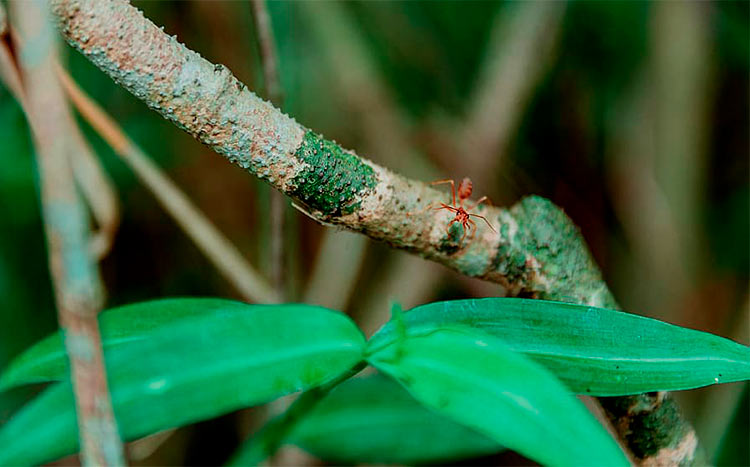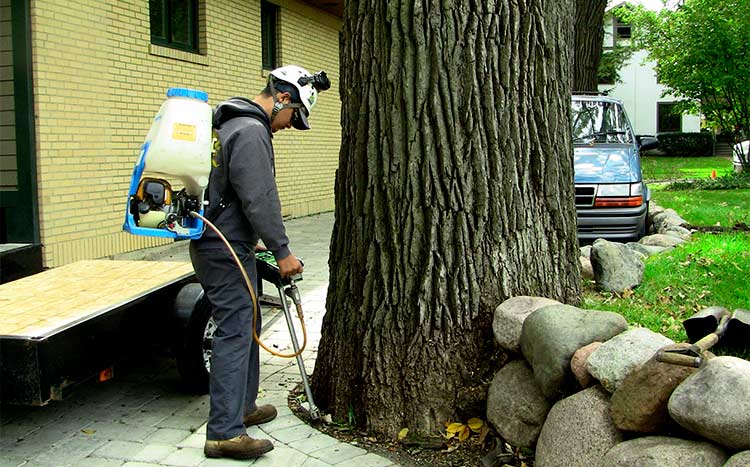Ants infest trees when they are either in search of honeydew or a home. And while they rarely destroy a tree directly, they can be a nuisance. This is because they can end up invading your home. They sometimes also inflict painful blisters. And in some cases, they can blacken leaves by leaving sooty mold colonies in their wake.
If your tree is infested with ants, the first thing that you should do is to wash off sap feeders by spraying the tree with a garden hose. You can also get rid of these feeders by spraying the tree with an insecticide. This will work because removing them will eliminate the one thing that attracts insects to your tree: honeydew-producing sap feeders. And since ants don’t like peppermint, spraying the tree with peppermint-infused water will repel them. Setting up ant traps can also work.
Here is what you should know about what you can do to free a tree from an ant infestation.

Table of contents
ToggleHow to get rid of the ants infesting a tree
While most ant species don’t pose a threat to the life of a tree, an ant infestation can be a nuisance. Some, like carpenter ants and red imported fire ants, tend to inflict painful stings. Others burrow through trees. And most of them tend to leave ugly traces of sooty mold on trees.
Here is what you should do in order to get rid of the ants infesting a tree.
Step 1
Take a gallon of water and place it in a bucket. Add about 30 drops of peppermint to the water and then thoroughly mix it.
Step 2
With the solution ready, use a sprayer to spray it all over the tree, starting from the base of the tree. The peppermint in the solution will be enough to repel them. Do this a few times and you will start seeing less ant activity on your tree.
Step 3
With the tree soaked in ant-repellent peppermint, it is now time to find their nest. Start by poking around the tree, looking for an opening that the ants might be using. An earth scraper will make your work easier, and so you should use it. In some cases, ants leave ugly marks behind and so following the trail of these marks could lead you to the nest.
Step 4
After you find the nest, you should purchase a strong insecticide and then prepare it according to the manufacturer’s instructions. Fill it into a sprayer and then spray it into the entry hole until you soak it.
Step 5
With the nest cavity soaked in insecticide, it is now time to discourage foraging ants from continuing with their activity. To do so, simply spray their trails with the insecticide. You may have to do this on a yearly basis in order to completely get rid of them.
Step 6
While it isn’t necessary, setting up baits can help to further shield your tree from ant activity especially if the tree is weak or dying. Most of the baits in the market are laced with boric acid, and placing them at the foot of the tree or on the trails that are used by the ants, can go a long way towards speeding up the rate at which you get rid of the ants.
DIY vs. Calling a Professional
When it comes to getting rid of ants, you can choose to do it on your own or hire a professional. Both options have their advantages and disadvantages. And what is perfect for you will solely depend on your circumstances and preferences.
Do It Yourself
Some homeowners choose to turn the process of getting rid of ants into a DIY project. They buy the materials needed, rent out tools like sprayers, and then set aside time to do the spraying and trapping.
Pros
- It is cheaper since you don’t have to pay for labor
- It can make for a fun project with loved ones
- It is a great way of keeping busy
Cons
- It exposes you and your loved ones to toxic chemicals
- It is not as effective as professional ant removal
- It is time-consuming since you have to do it yourself
Call a Pro Exterminator
A professional exterminator has the experience and expertise needed to effectively get rid of ants from a tree. Getting your ant problem handled by such a professional comes with a number of advantages and disadvantages.
Pros
- The job will get done faster
- They are better suited to completely getting rid of the problem and so they will do a better job of ridding your property of ants
- It will save you time since you don’t have to be present in order to do the work
- It will spare you the risks that come with handling pesticides and other toxic chemicals
Cons
- It is relatively expensive — when compared to DIY
- The vetting and hiring process can be tedious and time-consuming
Do ants harm tree roots?
Yes, ants can harm young trees by exposing their roots and thereby causing them to dry out. However, when it comes to established trees, ants don’t generally harm them. In fact, they can sometimes help in improving the aeration in the soil that is next to the tree. Cases of ants feeding on other insects that can potentially harm trees are also common.

Can a tree with ant infestation be saved?
Yes, a tree with an ant infestation can be saved.
While an infestation is generally a sign of a dying tree, such trees can sometimes be saved by eliminating the root cause of the problem. Taking measures like cutting off diseased and dying parts, spraying the tree with pesticides, and supplying the tree with additional nutrients through fertilization, can help to save a tree from dying.
However, not every tree can be saved. If the tree has been harmed to such an extent it can no longer produce food or absorb moisture and nutrients, then removing it may be the only solution.
How to kill ants without killing a tree
You can kill ants without killing the tree by using baits that are made of boric acid. Since boric acid is an effective ant-killer, while at the same time being generally harmless to trees, using it is a great way of killing ants without killing the tree.
Furthermore, most industrial-grade insecticides that have been designed for use on trees are generally safe and so spraying them into the entry hole and along the insect trails, will kill the ants without killing the tree. And if you simply want to keep ants off your tree, spraying it with a peppermint solution will do the trick.
How to recognize early signs of ant infestation in a tree
The following are the most common signs of an ant infestation in a tree.
Sign 1: Presence of worker ants on or near the tree’s base
The first, and the most obvious, sign of an infestation is a large number of ants on your tree or on the base of the tree. These ants are usually worker ants that go foraging for food and other resources. And if they are in large numbers around or on your tree, chances are that they have made a colony on it.
Sign 2: Piles of wood shavings
Ants, like carpenter ants, create their homes by eating into the wood. As a result, they tend to leave piles of wood shavings as a byproduct. Therefore, if you notice these piles at the base of your tree, chances are that you are dealing with a severe infestation.
Sign 3: Faint rustling noises
In the course of creating their homes, ants have to burrow into the tree. This process usually produces faint noises, and if you pay close attention, you can possibly hear the rustling.
Sign 4: Holes on the tree
Ants typically dig into the tree in order to create their homes. These holes are usually easy to detect as ants usually enter and come from these holes continuously. As a result, if you are able to follow an ant trail and it leads to a hole in your tree, you definitely have an ant problem.
Use this free service to find an arborist near you
If you have a tree that is infested with ants, contacting an arborist as soon as possible is advisable. And the best way to do so is to start by visiting GoTreeQuotes.com. It offers a free service that quickly matches you with the top-voted local tree care experts in your area.
Using the website, you can get 3 estimates fast by real certified experts in your area in just 2 minutes. Here is how it works.
- You scroll to the top of the page and enter your Zip code.
- Answer questions about your ant infestation problem
- Your details will be forwarded to three local experts.
- You will then receive a price estimate for the job and some friendly advice.
IMPORTANT: There is no obligation to hire. This is a free tool and service to be used at your pleasure.
Since 2012, Go Tree Quotes has helped over 74,516 homeowners
find the best deal on tree pruning in their local area.












